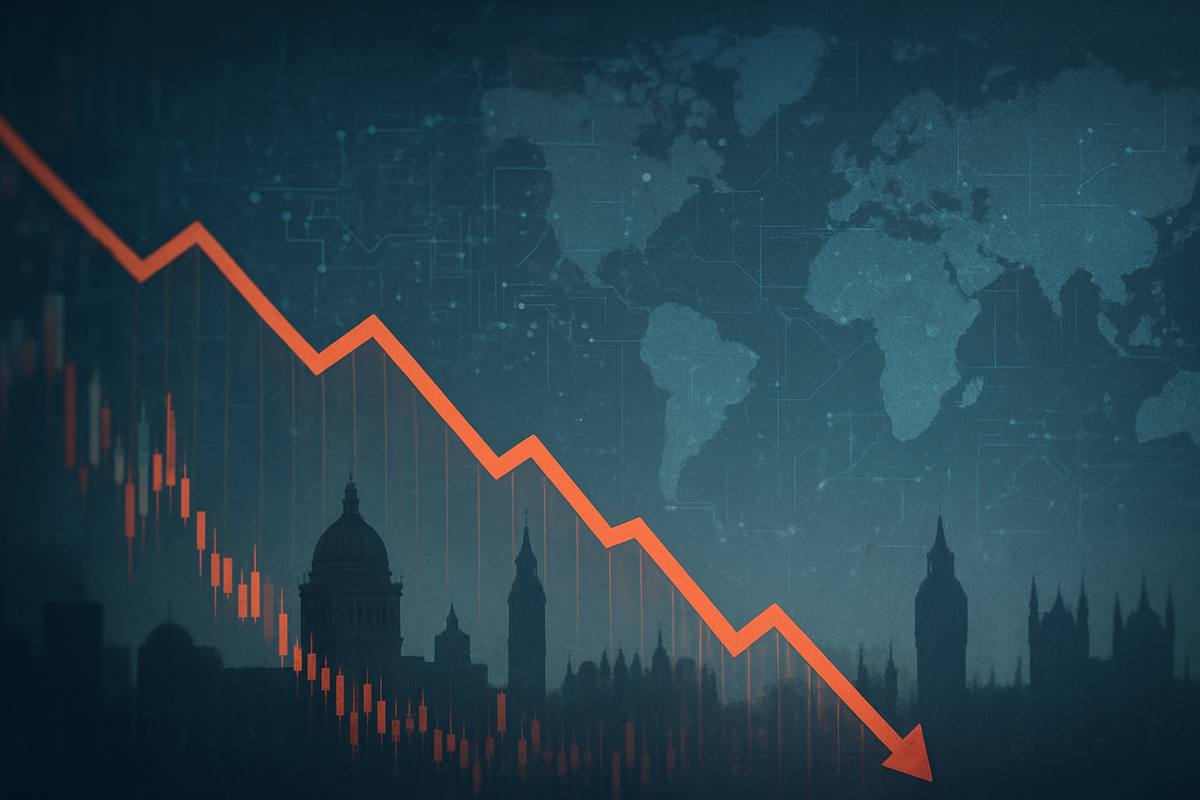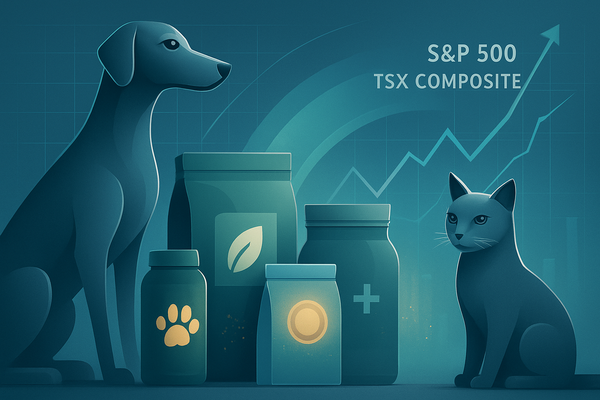European Stocks Brace for Worst Weekly Slump Since August Amid Global Tech Jitters and UK Market Turmoil

European stock markets are currently experiencing their most significant weekly decline since late August, casting a shadow of "risk-off" sentiment across global financial markets. As of November 7, 2025, the pan-European STOXX 600 index has recorded a weekly loss of 1.3%, marking its largest two-week fall since early September. This downturn is not isolated, with UK stocks, bonds, and the pound also sliding, reflecting a broader investor retreat from riskier assets amid a cocktail of economic uncertainties and valuation concerns.
The immediate implications for the market are characterized by heightened uncertainty and a prevailing cautious sentiment. Investors are pulling back from growth-oriented assets as concerns mount over global economic health and the sustainability of high valuations, particularly within the burgeoning Artificial Intelligence (AI) sector. This market recalibration suggests a period of introspection for investors and a re-evaluation of portfolios in the face of evolving economic landscapes.
The Current Downturn: A Deep Dive into European and UK Markets
The recent market turbulence has seen significant movements across major European indices. On November 7, 2025, the STOXX 600 closed down 0.6%, contributing to its substantial weekly decline. The Euro Area's main stock market index, the EU50, also fell by 0.49% on the same day and has seen a 1.25% decline over the past month. This widespread sell-off is largely attributed to growing jitters over elevated valuations in technology-related stocks globally, with fears of an "AI bubble" potentially bursting spreading from the US to Asia and Europe. Other contributing factors include the ongoing US government shutdown, hawkish commentary from the Federal Reserve, and a lack of clear US economic data, all fostering a "risk-off" environment.
The UK market has mirrored this European trend. The FTSE 100 (LSE: UKX) index closed down 53 points, or 0.55%, on November 7, 2025, reaching a near two-week low and ending the week with a 0.4% fall. The more domestically focused FTSE 250 (LSE: MCX) shed a more substantial 1.8%. Specific corporate news has also influenced the UK market, with Rightmove (LSE: RMV) shares plunging after the property portal announced increased spending on AI, and airline group IAG (LSE: IAG) falling after reporting a slowdown in demand for North American flights. Conversely, some companies, like ITV (LSE: ITV), saw their shares jump on specific corporate developments, such as the potential sale of its broadcasting arm.
UK government bonds, or gilts, have shown mixed movements. The yield on the United Kingdom 10-year Gilt Bond rose to 4.47% on November 7, 2025, while the 30-year gilt yield increased to 5.25%. However, both yields have fallen over the past month, reflecting renewed hopes for Bank of England interest rate cuts and anticipation of a market-friendly Autumn Budget. The Bank of England's Monetary Policy Committee voted 5-4 to keep interest rates unchanged at 4% earlier in the week, a tight decision many economists interpret as a "dovish hold," signaling potential rate cuts as early as December if inflation continues to ease. The British Pound (GBP) has also experienced volatility, trading near a seven-month low around $1.305 following the Bank of England's decision. While the GBP/USD exchange rate saw a slight rise to 1.3162 on November 7, 2025, it has weakened by 1.81% over the past month, pressured by a strengthening US dollar and increased market expectations for BoE rate cuts. The upcoming UK Autumn Budget on November 26, 2025, remains a critical event for traders.
Commodity Markets and Corporate Fortunes: Who Wins and Who Loses?
A "risk-off" global market sentiment, coupled with declining European stocks, profoundly impacts commodity demand, creating distinct winners and losers across various commodities and the public companies involved in their production and trade. When investors prioritize capital preservation, they typically shift away from riskier assets like commodities, especially those tied to industrial activity and global economic growth.
Potential Losers: Industrial metals and energy commodities are particularly vulnerable. A global economic slowdown, persistent property market crises (such as in China), and reduced industrial production directly lead to decreased demand and lower prices for industrial metals like copper, iron ore, aluminum, and zinc. Major diversified mining companies like BHP (ASX: BHP, LSE: BHP) and steel companies would face significant headwinds, experiencing revenue declines, squeezed profit margins, and operational adjustments. Similarly, crude oil and natural gas demand is highly sensitive to economic activity. Diminished demand for oil due to economic slowdowns causes prices to fall, impacting major integrated oil and gas companies such as ExxonMobil (NYSE: XOM) and Chevron (NYSE: CVX), as well as oilfield service providers like Schlumberger (NYSE: SLB) and Halliburton (NYSE: HAL).
Potential Winners (or Relatively Resilient): In contrast, traditional safe-haven assets tend to benefit during periods of market instability. Gold, historically a refuge during economic downturns and geopolitical uncertainty, often sees increased demand and rising prices. Gold mining companies, such as Barrick Gold (NYSE: GOLD, TSX: ABX) or Newmont (NYSE: NEM), can perform well, offering leveraged exposure to rising gold prices. Silver also acts as a safe-haven, though its industrial uses mean its price can be more susceptible to broader economic slowdowns. Essential agricultural staples, like corn and soybeans, tend to maintain stable demand as consumers continue to purchase basic food products, providing some stability for producers in this sector, although they still face challenges from input costs.
Broader Implications: Unpacking the Wider Significance for Global Finance
The current European stock decline, its worst weekly fall since August, is more than just a regional blip; it reflects a complex interplay of global economic uncertainties and specific industry pressures, carrying significant implications for broader industry trends, international partners, regulatory frameworks, and drawing parallels to historical market volatility.
This downturn is primarily characterized by a global "risk-off" sentiment, largely driven by concerns over potentially overvalued Artificial Intelligence (AI) companies, particularly in the US, and general economic anxieties. The narrow market rally, heavily reliant on a few large technology companies, has proven vulnerable to these valuation concerns, triggering apprehension across global bourses. Within Europe, the decline has been broad-based, affecting telecommunications, retail, and the materials and mining sectors, signaling a reassessment of corporate valuations and a move away from riskier assets. The interconnectedness of global financial markets means that a significant downturn in US stocks can quickly transmit apprehension to Europe, underscoring how regional tremors can become international quakes, potentially leading to a reallocation of global investment flows and tighter credit conditions. Major economies experiencing sustained downturns could also negatively impact international trade and supply chains, especially if US tariffs intensify trade protectionism.
Central banks and governments are actively responding to this market volatility. The European Central Bank (ECB) has kept its rates unchanged but anticipates further cuts in 2025, while the Bank of England (BoE) has signaled potential December easing. The US Federal Reserve faces challenges with limited economic data due to the government shutdown, complicating interest rate decisions. Governments are also expected to increase intervention in response to geopolitical risks, and there's a focus on streamlining existing EU sustainability rules to cut red tape and reduce "regulatory volatility" for companies. Historically, the current concerns over stretched tech valuations and geopolitical tensions draw parallels to previous periods of market upheaval, such as the 2008 sub-prime mortgage crisis, the 1987 Black Monday, and the 2000 dot-com bubble, all demonstrating how shocks in one market can ripple globally.
The Path Ahead: Navigating Short-Term Volatility and Long-Term Prospects
The European stock market's recent downturn marks a period of recalibration, yet many analysts maintain a constructive outlook for European equities in the medium to long term. In the immediate aftermath, continued market volatility is expected as investors re-evaluate valuations, especially in the technology and AI sectors. Economic data, particularly unemployment figures and consumer confidence, along with central bank communications, will be closely watched for signals of policy shifts. Despite the recent fall, improving corporate earnings forecasts, accommodative monetary policies from the ECB, and fiscal support from countries like Germany could present attractive buying opportunities.
Looking further ahead, European stocks are poised for a potential recovery and could even outperform their US counterparts through the remainder of 2025 and into 2026. This optimism is fueled by rising liquidity, continued German fiscal stimulus, anticipated acceleration in corporate earnings growth for 2026, and attractive valuations relative to the US market. The ECB is expected to continue its cautious rate-cutting cycle, which could benefit indebted sectors like telecommunications and real estate, as well as consumer-facing industries. The development of the EU Savings and Investment Union is also seen as a potential source of sustained, long-term support. For businesses, strategic pivots towards prioritizing profitability, cost efficiency, and sustainable models are crucial, while investors are advised to balance short-term caution with a long-term perspective, emphasizing diversification, quality assets, and fundamental analysis.
Emerging market (EM) equities have shown strong performance in 2025, outperforming developed markets, driven by a weakening US dollar and renewed interest in undervalued regions. Opportunities exist in local currency EM debt, supported by resilient economic conditions and disinflation. Geographic diversification into Southeast Asia, Eastern Europe, and Africa is gaining traction. China presents a complex picture; while facing domestic vulnerabilities, Beijing's monetary and fiscal policies could foster a recovery, positively impacting European export-dependent sectors. Potential scenarios range from a quick recovery and outperformance of European equities, driven by improving earnings and supportive policies, to continued volatility and market recalibration. However, persistent geopolitical tensions and intensified US trade protectionism remain significant headwinds that could lead to a more prolonged downturn.
Market Crossroads: A Comprehensive Wrap-up and Investor Outlook
The recent decline in European stocks, marking their worst weekly performance since August, serves as a significant market correction rather than a fundamental shift in the broader positive trajectory for European markets in 2025. Key takeaways include the market's sensitivity to AI valuation concerns and a broader tech selloff, the unsettling impact of the US government shutdown and its data vacuum, and the nuanced signals from central bank monetary policies. Mixed corporate earnings and ongoing global trade uncertainties further contributed to the prevailing "risk-off" sentiment.
Moving forward, the market is likely to remain cautious in the immediate term, but the medium-term outlook for European equities appears more constructive. Despite the recent dip, European markets have demonstrated strong year-to-date performance in 2025, underpinned by a strengthening macroeconomic environment, easing inflation risks, and potential for further interest rate cuts. European stocks are also considered attractively priced compared to their US counterparts, suggesting a potential for outperformance into 2026.
The significance and lasting impact of this event lie in its exposure of market vulnerabilities – particularly the heavy reliance on a few large tech companies and the market's sensitivity to external shocks. It underscores the importance of diversified growth drivers and a robust economic foundation. For investors, vigilance is paramount. They should closely monitor the resolution of the US government shutdown and the subsequent release of economic data, inflation trends and central bank policies (especially from the ECB and Bank of England), and ongoing corporate earnings reports. The sustainability of AI sector valuations will remain a critical concern, as will geopolitical developments and trade relations. Finally, the effectiveness of European fiscal stimulus and the broader pace of cyclical recovery in Europe will be key indicators for European equities outperforming their global peers in the coming months.
This content is intended for informational purposes only and is not financial advice



